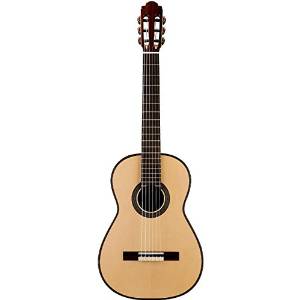Back to the main page Back to category Cordoba
musical instrument details
Cordoba Master Series Torres
Estimated price for orientation: 3 499 $
Category: Cordoba
Class:
Features Top: Solid Engelmann spruce, Back & Sides: Solid Indian rosewood Neck/Fingerboard: Spanish cedar neck (Traditional/Classical Profile) / Ebony fingerboard Scale Length: 640mm (25.2"), Nut Width: 51mm (2") Strings: Savarez Cristal Corum High Tension 500CJ, Electronics: N/A Case: Hardshell Cordoba humidified archtop case Description Product Description The Torres is a small body guitar with a big voice and a shortened scale length. It features a narrower nut width and slightly narrower neck that is extremely comfortable to play. This guitar is handmade in the USA. Beyond the beauty of the construction, one of the most amazing characteristics of an original Torres guitar is the amount of sound produced by such a small and lightweight instrument. After examining three authentic Torres guitars, we decided to base the construction of our own Torres on an 1856 model that features a smaller body (24.8") and shorter scale length (640mm). The Cordoba Torres is built with a solid Engelmann spruce top and solid Indian rosewood back and sides. The neck is Spanish cedar, topped with an African ebony fingerboard. A few modern refinements such as a truss rod, geared tuning machines, durable finish, and non-gut strings were added to improve on what was not available in the 1800s but are essential today. The result is an instrument that exemplifies authentic Torres designs, voicing, and feel, and captures a rare piece of guitar making history. The three original Torres guitars were studied inside and out and played over and over. The mission was to understand the essence of what gives this iconic guitar such an amazing voice and feel, and then recreate an instrument that possesses these characteristics and carries the same magic in its DNA. The process was a combination of science and feel; the wood thicknesses of the top, backs, sides, and braces were measured to the nearest hundredth of a millimeter, bracing patterns traced and mapped, and details of the materials, inlays, wood grains, and vibrations were all carefully analyzed. The guitars were played and listened to for hours to gain an understanding of the balance between the trebles and basses, resonance of the tops, and a sense for the feel and response of each guitar when played in a variety of styles and environments.
Features Top: Solid Engelmann spruce, Back & Sides: Solid Indian rosewood Neck/Fingerboard: Spanish cedar neck (Traditional/Classical Profile) / Ebony fingerboard Scale Length: 640mm (25.2"), Nut Width: 51mm (2") Strings: Savarez Cristal Corum High Tension 500CJ, Electronics: N/A Case: Hardshell Cordoba humidified archtop case Description Product Description The Torres is a small body guitar with a big voice and a shortened scale length. It features a narrower nut width and slightly narrower neck that is extremely comfortable to play. This guitar is handmade in the USA. Beyond the beauty of the construction, one of the most amazing characteristics of an original Torres guitar is the amount of sound produced by such a small and lightweight instrument. After examining three authentic Torres guitars, we decided to base the construction of our own Torres on an 1856 model that features a smaller body (24.8") and shorter scale length (640mm). The Cordoba Torres is built with a solid Engelmann spruce top and solid Indian rosewood back and sides. The neck is Spanish cedar, topped with an African ebony fingerboard. A few modern refinements such as a truss rod, geared tuning machines, durable finish, and non-gut strings were added to improve on what was not available in the 1800s but are essential today. The result is an instrument that exemplifies authentic Torres designs, voicing, and feel, and captures a rare piece of guitar making history. The three original Torres guitars were studied inside and out and played over and over. The mission was to understand the essence of what gives this iconic guitar such an amazing voice and feel, and then recreate an instrument that possesses these characteristics and carries the same magic in its DNA. The process was a combination of science and feel; the wood thicknesses of the top, backs, sides, and braces were measured to the nearest hundredth of a millimeter, bracing patterns traced and mapped, and details of the materials, inlays, wood grains, and vibrations were all carefully analyzed. The guitars were played and listened to for hours to gain an understanding of the balance between the trebles and basses, resonance of the tops, and a sense for the feel and response of each guitar when played in a variety of styles and environments.
